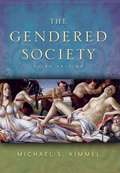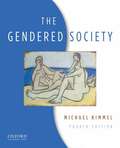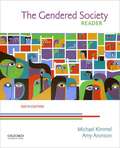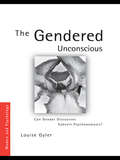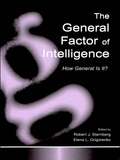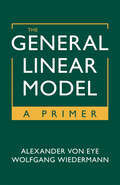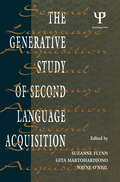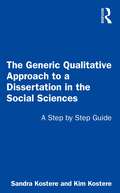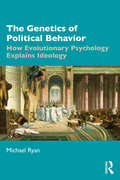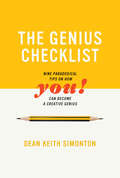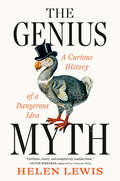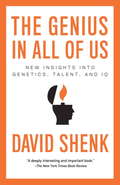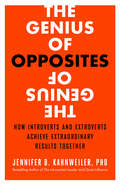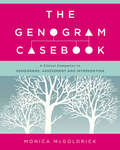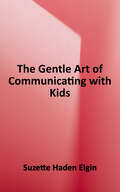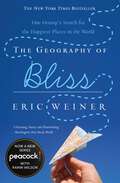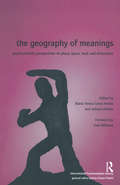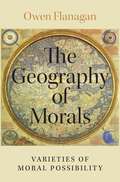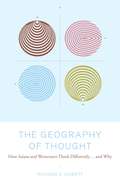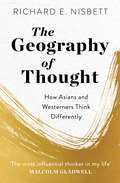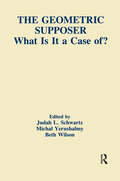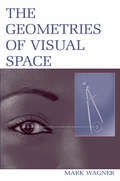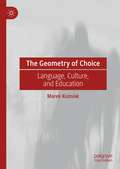- Table View
- List View
The Gendered Society (3rd edition)
by Michael S. KimmelThoroughly updated and revised, the third edition of The Gendered Society explores current thinking about gender, both inside academia and in our everyday lives.
The Gendered Society (4th edition)
by Michael S. KimmelThoroughly updated throughout, the fourth edition of The Gendered Society explores current thinking about gender, both inside academia and in our everyday lives. Michael Kimmel challenges the claim that gender is limited to women's experiences-his compelling and balanced study of gender includes both masculine and feminine perspectives. Kimmel makes three bold and persuasive statements about gender. First, he demonstrates that gender differences are often extremely exaggerated; in fact, he argues that men and women have much more in common than we think they do. Kimmel also challenges the pop psychologists who suggest that gender difference is the cause of inequality between the sexes; instead, he reveals that the reverse is true-gender inequality itself is the cause of the differences between men and women. Finally, he illustrates that gender is not merely an element of individual identity, but a socially constructed institutional phenomenon. Essential reading for both students and scholars, The Gendered Society is an authoritative, incisive, and lively statement about contemporary gender relations from one of the country's foremost thinkers on the subject.
The Gendered Society Reader
by Michael Kimmel Amy AronsonIn The Gendered Society Reader, Sixth Edition, coeditors Michael Kimmel and Amy Aronson pull together an array of dynamic voices--both male and female, classic and contemporary--to examine various interpretations of gender. These lively, in-depth readings explore gender discourse over a wide range of disciplines, focusing primarily on two central issues: difference and domination. Carefully balanced to reflect the diversity of its subject, this text addresses provocative and fundamental questions including: * How are males and females different? * What do these differences mean? * How to various cultures and religions interpret gender? * Why do societies continue to differentiate people on the basis of gender? * Why is it that almost every known society is based on male domination? Thoroughly updated with rich and timely material, the sixth edition is the perfect complement to Michael Kimmel's textbook, The Gendered Society, Sixth Edition (OUP, 2016).
The Gendered Unconscious: Can Gender Discourses Subvert Psychoanalysis? (Women and Psychology)
by Louise GylerFeminist interventions in psychoanalysis have often attempted either to subvert or re-frame the masculinist and phallocentric biases of Freud's psychoanalysis. This book investigates the nature of these interventions by comparing the status and treatment of women in two different psychoanalytic models: the Kleinian and the feminist models. It argues that, in fact, these interventions have historically tended to reinforce such biases by collapsing the distinction between the gendered minds of individuals and theories of gender. This investigation is framed by two steps. First, in assessing the position of women and the feminine in psychoanalysis, The Gendered Unconscious explores not only the ways they are represented in theory, but also how these representations function in practice. Secondly, this book uses a framework of a comparative dialogue to highlight the assumptions and values that underpin the theory and clinical practice in the two psychoanalytic models. This comparative critique concludes with the counter-intuitive claim that contemporary Kleinian theory may, in practice, hold more radical possibilities for the interests of women than the practices derived from contemporary psychoanalytic gender theory. This book is of significant interest to those studying the psychology of women, psychoanalytic studies, health psychology, sociology, gender studies and cultural studies. It will also be of interest to clinicians and candidates of professional psychotherapy and psychoanalytic training programmes.
The General Factor of Intelligence: How General Is It?
by Robert J. Sternberg Elena L. GrigorenkoThis edited volume presents a balanced approach to the ongoing debate of just how general the "general factor" of intelligence is. To accomplish this goal, the editors chose a number of distinct approaches to the study of intelligence--psychometric, genetic-epistemological, cognitive, biological, behavior-genetic, sociocultural, systems--and asked distinguished scholars to write from the standpoint of these approaches. Each approach comprises two chapters, one by a scholar leaning toward a view arguing for the greater generality of g, and the other by a scholar leaning toward a view arguing for the lesser generality of g. The scholars are not simply "for" or "against" these outlooks, rather they provide a more textured view of the general factor, attempting to explain it in psychological terms that are easily understandable. Intended for psychologists in all areas, including clinical, consulting, educational, cognitive, school, developmental, and industrial-organizational, this book will also be of interest to educators, sociologists, anthropologists, and those interested in the nature of intelligence.
The General Linear Model: A Primer
by Wolfgang Wiedermann Alexander von EyeGeneral Linear Model methods are the most widely used in data analysis in applied empirical research. Still, there exists no compact text that can be used in statistics courses and as a guide in data analysis. This volume fills this void by introducing the General Linear Model (GLM), whose basic concept is that an observed variable can be explained from weighted independent variables plus an additive error term that reflects imperfections of the model and measurement error. It also covers multivariate regression, analysis of variance, analysis under consideration of covariates, variable selection methods, symmetric regression, and the recently developed methods of recursive partitioning and direction dependence analysis. Each method is formally derived and embedded in the GLM, and characteristics of these methods are highlighted. Real-world data examples illustrate the application of each of these methods, and it is shown how results can be interpreted.
The Generative Study of Second Language Acquisition
by Suzanne Flynn Gita Martohardjono Wayne O'NeilThe vast majority of work in theoretical linguistics from a generative perspective is based on first language acquisition and performance. The vast majority of work on second language acquisition is carried out by scholars and educators working within approaches other than that of generative linguistics. In this volume, this gap is bridged as leading generative linguists apply their intellectual and disciplinary skills to issues in second language acquisition. The results will be of interest to all those who study second language acquisition, regardless of their theoretical perspective, and all generative linguists, regardless of the topics on which they work.
The Generic Qualitative Approach to a Dissertation in the Social Sciences: A Step by Step Guide
by Sandra Kostere Kim KostereThe Generic Qualitative Approach to a Dissertation in the Social Sciences: A Step by Step Guide is a practical guide for the graduate students and faculty planning and executing a generic qualitative dissertation in the social sciences. Generic qualitative research is a methodology that seeks to understand human experience by taking a qualitative stance and using qualitative procedures. Based on Sandra Kostere and Kim Kostere’s experiences of serving on dissertation committees, this book aims to demystify both the nuances and the procedures of qualitative research, with the aim of empowering students to conduct meaningful dissertation research and present findings that are rigorous, credible, and trustworthy. It examines the fundamental principles and assumptions underlying the generic qualitative method, then covers each stage of the research process including creation of research questions, interviews, and then offers three ways of analyzing the data gathered and presenting the results. With examples of the generic qualitative method in practice to show students how to conduct their research confidently, and chapters designed to walk the researcher through each step of the dissertation process, this book is specifically tailored for the accessible generic method, and will be useful for graduate students and faculty developing dissertations in Psychology, Education, Nursing and the social sciences.
The Genetics of Political Behavior: How Evolutionary Psychology Explains Ideology
by Michael RyanIn this unique amalgam of neuroscience, genetics, and evolutionary psychology, Ryan argues that leftists and rightists are biologically distinct versions of the human species that came into being at different moments in human evolution. The book argues that the varying requirements of survival at different points in history explain why leftists and rightists have anatomically different brains as well as radically distinct behavioral traits. Rightist traits such as callousness and fearfulness emerged early in evolution when violence was pervasive in human life and survival depended on the fearful anticipation of danger. Leftist traits such as pro-sociality and empathy emerged later as environmental adversity made it necessary for humans to live in larger social groups that required new adaptive behavior. The book also explores new evolutionary theories that emphasize the role of the environment in shaping not only human political behavior but also humans' genetic architecture. With implications for the future of politics, the book explores how the niche worlds we build for ourselves through political action can have consequences for the evolution of the species. Proposing a new way of understanding human politics, this is fascinating reading for students and academics in psychology, the social sciences, and humanities, as well as general readers interested in political behavior.
The Genius Checklist: Nine Paradoxical Tips on How You Can Become a Creative Genius (The\mit Press Ser.)
by Dean Keith SimontonWhat it takes to be a genius: nine essential and contradictory ingredients.What does it take to be a genius? A high score on an IQ test? Brilliant physicist Richard Feynman's IQ was too low for membership in Mensa. Suffering from varying degrees of mental illness? Creativity is often considered a marker of mental health. Be a child prodigy like Mozart, or a later bloomer like Beethoven? Die tragically young, like Keats, or live to a ripe old age like Goethe? In The Genius Checklist, Dean Keith Simonton examines the key factors in creative genius and finds that they are more than a little contradictory. Simonton, who has studied creativity and genius for more than four decades, draws on both scientific research and stories from the lives of famous creative geniuses that range from Isaac Newton to Vincent van Gogh to Virginia Woolf. He explains the origin of IQ tests and the art of estimating the IQ of long-dead historical figures (John Stuart Mill: 200; Charles Darwin: 160). He compares IQ scores with achieved eminence as measures of genius, and he draws a distinction between artistic and scientific genius. He rules out birth order as a determining factor (in the James family alone, three geniuses at three different birth-order positions: William James, firs-tborn; Henry James, second born; Alice James, born fifth and last); considers Malcolm Gladwell's 10,000 hour rule; and describes how the “lone” genius gets enmeshed in social networks.Genius, Simonton explains, operates in ways so subtle that they seem contradictory. Genius is born and made, the domain of child prodigies and their elders. Simonton's checklist gives us a new, integrative way to understand geniuses—and perhaps even to nurture your own genius!
The Genius Myth: A Curious History of a Dangerous Idea
by Helen LewisFrom acclaimed Atlantic staff writer and host of BBC&’s podcast &“The New Gurus&” Helen Lewis comes a timely and provocative interrogation of the myth of genius, exploring the surprising inventions, inspirations and distortions by which some lives are elevated to 'greatness' - and others are not*A Guardian, Financial Times, New Statesman and GQ Book for 2025*You can tell what a society values by who it labels as a genius. You can also tell who it excludes, who it enables, and what it is prepared to tolerate. In The Genius Myth, Helen Lewis unearths how this one word has shaped (and distorted) our ideas of success and achievement.Ultimately, argues Lewis, the modern idea of genius — a single preternaturally gifted individual, usually white and male, exempt from social niceties and sometimes even the law— has run its course. Braiding deep research with her signature wit and lightness, Lewis dissects past and present models of genius in the West, and reveals a far deeper and more interesting picture of human creativity than conventional wisdom allows. She uncovers a battalion of overlooked wives and collaborators. She asks whether most inventions are inevitable. She wonders if the Beatles would succeed today. And she confronts the vexing puzzle of Elon Musk, the tech disrupter who fancies himself as an ubermensch.Smart, funny, and provocative, The Genius Myth will challenge your assumptions about creativity, productivity, and innovation --- and forever alter your mental image of the so-called &“genius.&”
The Genius in All of Us
by David ShenkWith irresistibly persuasive vigor, David Shenk debunks the long-standing notion of genetic "giftedness," and presents dazzling new scientific research showing how greatness is in the reach of every individual.DNA does not make us who we are. "Forget everything you think you know about genes, talent, and intelligence," he writes. "In recent years, a mountain of scientific evidence has emerged suggesting a completely new paradigm: not talent scarcity, but latent talent abundance."Integrating cutting-edge research from a wide swath of disciplines--cognitive science, genetics, biology, child development--Shenk offers a highly optimistic new view of human potential. The problem isn't our inadequate genetic assets, but our inability, so far, to tap into what we already have. IQ testing and widespread acceptance of "innate" abilities have created an unnecessarily pessimistic view of humanity--and fostered much misdirected public policy, especially in education.The truth is much more exciting. Genes are not a "blueprint" that bless some with greatness and doom most of us to mediocrity or worse. Rather our individual destinies are a product of the complex interplay between genes and outside stimuli-a dynamic that we, as people and as parents, can influence.This is a revolutionary and optimistic message. We are not prisoners of our DNA. We all have the potential for greatness.From the Trade Paperback edition. and has access to the web.
The Genius of Genesis
by Dennis G. ShulmanA profound and eloquent reading of the first chapter of the Bible.
The Genius of Opposites: How Introverts and Extroverts Achieve Extraordinary Results Together
by Jennifer B. KahnweilerBetter TogetherFDR and Eleanor. Mick and Keith. Jobs and Woz. There are countless examples of introvert-extrovert partnerships who make brilliant products, create great works of art, and even change history together. But these partnerships don't just happen. They demand wise nurturing. The key, says bestselling author Jennifer Kahnweiler, is for opposites to stop emphasizing their differences and use approaches that focus them both on moving toward results. Kahnweiler's first-of-its-kind practical five-step process helps introverts and extroverts understand and appreciate each other's wiring, use conflicts to spur creativity, enrich their own skills by learning from the other, and see and act on things neither would have separately. Kahnweiler shows how to perform the delicate balancing act required to create a whole that is exponentially greater than the sum of its parts.
The Genogram Casebook: Assessment and Intervention
by Monica McgoldrickA long-awaited workbook companion to Monica McGoldrick’s highly successful textbook Genograms. This clinical companion to the bestselling Genograms: Assessment & Intervention uses case examples to articulate the most effective ways to use genograms in clinical practice. Widely utilized by family therapists and health care professionals, the genogram is a graphic way of organizing the mass of information gathered during a family assessment and finding patterns in the family system for more targeted treatment. For a client with cutoff relationships or a history of trauma, it can be hard to talk to a therapist about past and present relationships. Genograms are a non-intrusive and non-confrontational way to learn about a client's history and chart crucial, complex information for effective assessment and therapy. The Genogram Casebook deploys richly detailed case examples to address resistance to genograms, overcoming dysfunctional relationship patterns, working with couples, navigating issues of divorce and remarriage, using genograms in family sessions with children, repairing conflict and cutoff with family members, looking at the therapist's own family, and much more. It's a vibrantly practical, decisively essential guide to the use of genograms in mental health practice.
The Gentle Art of Communicating with Kids
by Suzette Haden ElginBased on her proven techniques, the author gives parents, teachers, youth workers, law enforcement personnel, and anyone who needs to talk effectively with children a system of language behaviour that makes the task of communication easier and more effective.
The Geography of Bliss: One Grump's Search for the Happiest Places in the World
by Eric WeinerNow a new series on Peacock with Rainn Wilson, THE GEOGRAPHY OF BLISS is part travel memoir, part humor, and part twisted self-help guide that takes the viewer across the globe to investigate not what happiness is, but WHERE it is. Are people in Switzerland happier because it is the most democratic country in the world? Do citizens of Qatar, awash in petrodollars, find joy in all that cash? Is the King of Bhutan a visionary for his initiative to calculate Gross National Happiness? Why is Asheville, North Carolina so damn happy? In a unique mix of travel, psychology, science and humor, Eric Weiner answers those questions and many others, offering travelers of all moods some interesting new ideas for sunnier destinations and dispositions.
The Geography of Meanings: Psychoanalytic Perspectives on Place, Space, Land, and Dislocation (Ipa: The International Psychoanalysis Library)
by Salman AkhtarThis book is a collection of "stories", and just as the Stories of the Dreaming act as a container of experiences for the indigenous people, it attempts to be a container for experiences that had not had enough exposure in psychoanalytic literature.
The Geography of Morals: Varieties of Moral Possibility
by Owen FlanaganThe Geography of Morals is a work of extraordinary ambition: an indictment of the parochialism of Western philosophy, a comprehensive dialogue between anthropology, empirical moral psychology, behavioral economics, and cross-cultural philosophy, and a deep exploration of the opportunities for self, social, and political improvement provided by world philosophy. Flanagan presses the much more exciting possibility that cross-cultural philosophy provides opportunities for exploring the varieties of moral possibility, learning from other traditions, and for self, social, and political improvement. There are ways of world making in other living traditions - Confucian, Daoist, Buddhist, Hindu, Jain, Muslim, Amerindian,and African - that citizens in Western countries can benefit from. Cross-cultural learning is protection against what Alasdair MacIntyre refers to as being "imprisoned by one's upbringing. " Flanagan takes up perennial topics of whether there is anything to the idea of a common human nature, psychobiological sources of human morality, the nature of the self, the role of moral excellence in a good human life, and whether and how empirical inquiry into morality can contribute to normative ethics. The Geography of Morals exemplifies how one can respectfully conceive of multiculturalism and global interaction as providing not only opportunities for business and commerce, but also opportunities for socio-moral and political improvement on all sides. This is a book that aims to change how normative ethics and moral psychology are done.
The Geography of Thought
by Richard NisbettEveryone knows that while different cultures may think about the world differently, they use the same equipment for doing their thinking. Everyone knows that whatever the skin color, nationality, or religion, every human being uses the same tools for perception, for memory, and for reasoning. Everyone knows that a logically true statement is true in English, German, or Hindi. Everyone knows that when a Chinese and an American look at the same painting, they see the same painting.But what if everyone is wrong?When psychologist Richard E. Nisbett showed an animated underwater scene to his American students, they zeroed in on a big fish swimming among smaller fish. Japanese subjects, on the other hand, made observations about the background environment -- and the different "seeings" are a clue to profound underlying cognitive differences between Westerners and East Asians. For, as Professor Nisbett shows in The Geography of Thought, people actually think about -- and even see -- the world differently because of differing ecologies, social structures, philosophies, and educational systems that date back to ancient Greece and China and that have survived into the modern world. As a result, East Asian thought is "holistic" -- drawn to the perceptual field as a whole and to relations among objects and events within that field. By comparison to Western modes of reasoning, East Asian thought relies far less on categories or on formal logic; it is fundamentally dialectic, seeking a "middle way" between opposing thoughts. By contrast, Westerners focus on salient objects or people, use attributes to assign them to catergories, and apply rules of formal logic to understand their behavior. The Geography of Thought documents Professor Nisbett's groundbreaking international research in cultural psychology, a series of comparative studies both persuasive in their rigor and startling in their conclusions, addressing questions such as: Why did the ancient Chinese excel at algebra and arithmetic, but not geometry, the brilliant achievement of such Greeks as Euclid? Why do East Asians find it so difficult to disentangle an object from its surroundings? Why do Western infants learn nouns more rapidly than verbs, when it is the other way around in East Asia? What are the implications of these cognitive differences for the future of international politics? Do they support a Fukuyamaesque "end of history" scenario or a Huntingtonian "clash of civilizations"?From feng shui to metaphysics, from comparative linguistics to economic history, a gulf separates the children of Aristotle from the descendants of Confucius. At a moment in history when the need for cross-cultural understanding and collaboration have never been more important, The Geography of Thought offers both a map to that gulf and a blueprint for a bridge that might be able to span it.
The Geography of Thought: How Asians and Westerners Think Differently - and Why
by Richard E. NisbettWhen Richard Nisbett showed an animated underwater scene to his American students, they zeroed in on a big fish swimming among smaller fish. Japanese subjects, on the other hand, made observations about the background environment...and the different "seeings" are a clue to profound underlying cognitive differences between Westerners and East Asians. As Professor Nisbett shows in The Geography of Thought people actually think - and even see - the world differently, because of differing ecologies, social structures, philosophies, and educational systems that date back to ancient Greece and China, and that have survived into the modern world. As a result, East Asian thought is "holistic" - drawn to the perceptual field as a whole, and to relations among objects and events within that field. By comparison to Western modes of reasoning, East Asian thought relies far less on categories, or on formal logic; it is fundamentally dialectic, seeking a "middle way" between opposing thoughts. By contrast, Westerners focus on salient objects or people, use attributes to assign them to categories, and apply rules of formal logic to understand their behaviour.
The Geography of Thought: How Asians and Westerners Think Differently... and Why
by Richard E. NisbettWhen psychologist Richard E. Nisbett showed an animated underwater scene to his American students, they zeroed in on a big fish swimming among smaller fish. Japanese observers instead commented on the background environment -- and the different "seeings" are a clue to profound cognitive differences between Westerners and East Asians. As Nisbett shows in The Geography of Thought, people think about -- and even see -- the world differently because of differing ecologies, social structures, philosophies, and educational systems that date back to ancient Greece and China. The Geography of Thought documents Professor Nisbett's groundbreaking research in cultural psychology, addressing questions such as: Why did the ancient Chinese excel at algebra and arithmetic, but not geometry, the brilliant achievement of such Greeks as Euclid? Why do East Asians find it so difficult to disentangle an object from its surroundings? Why do Western infants learn nouns more rapidly than verbs, when it is the other way around in East Asia? At a moment in history when the need for cross-cultural understanding and collaboration have never been more important, The Geography of Thought offers both a map to that gulf and a blueprint for a bridge that might be able to span it.
The Geometric Supposer: What Is It A Case Of? (Technology and Education Series)
by Beth Wilson Judah L. Schwartz Michal YerushalmyThis volume is a case study of education reform and innovation using technology that examines the issue from a wide variety of perspectives. It brings together the views and experiences of software designers, curriculum writers, teachers and students, researchers and administrators. Thus, it stands in contrast to other analyses of innovation that tend to look through the particular prisms of research, classroom practice, or software design. The Geometric Supposer encourages a belief in a better tomorrow for schools. On its surface, the Geometric Supposer provides the means for radically altering the way in which geometry is taught and the quality of learning that can be achieved. At a deeper level, however, it suggests a powerful metaphor for improving education that can be played out in many different instructional contexts.
The Geometries of Visual Space
by Mark WagnerWhen most people think of space, they think of physical space. However, visual space concerns space as consciously experienced, and it is studied through subjective measures, such as asking people to use numbers to estimate perceived distances, areas, angles, or volumes. This book explores the mismatch between perception and physical reality, and describes the many factors that influence the perception of space including the meaning assigned to geometric concepts like distance, the judgment methods used to report the experience, the presence or absence of cues to depth, and the orientation of a stimulus with respect to point of view. The main theme of the text is that no single geometry describes visual space, but that the geometry of visual space depends upon the stimulus conditions and mental shifts in the subjective meaning of size and distance.In addition, The Geometries of Visual Space:*contains philosophical, mathematical, and psychophysical background material;*looks at synthetic approaches to space perception including work on hyperbolic, spherical, and Euclidean geometries;*presents a meta-analysis of studies that ask observers to directly estimate size, distance, area, angle, and volume;*looks at the size constancy literature in which observers are asked to adjust a comparison stimulus to match a variety of standards at different distances away;*discusses research that takes a multi-dimensional approach toward studying visual space; and*discusses how spatial experience is influenced by memory.While this book is primarily intended for scholars in perception, mathematical psychology, and psychophysics, it will also be accessible to a wider audience since it is written at a readable level. It will make a good graduate-level textbook on space perception.
The Geometry of Choice: Language, Culture, and Education
by Marek KuźniakThis book offers a cognitive-semantic insight into the roots of the human decisionmaking process, using the metaphor of CHOICE as CUBE. The areas of key interest are language, culture, and education as forms of social organization. This book addresses issues relevant to a number of fields, including social epistemology, cognitive linguistics, cognitive anthropology, philosophy, culture and education studies, and will be of interest to readers in these and related disciplines.
